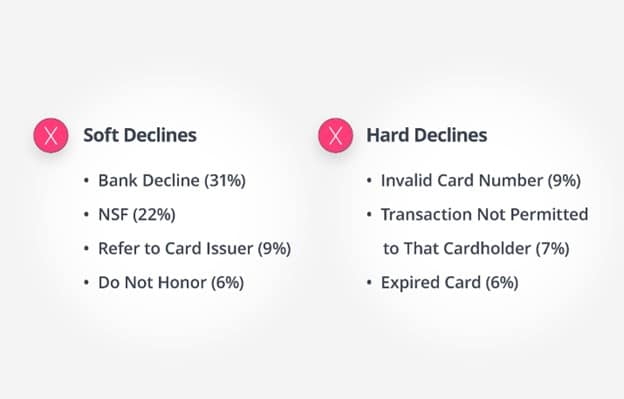
Delivering a Great Customer Experience — Even When a Payment Fails
Subscription customers are committed to an ongoing relationship in which they pay for regular delivery of products or services. This creates a very different experience and a greater perceived value from the infrequent, single purchase transactional relationships other business types have with their customers. For this reason, subscription companies must be customer-obsessed — the success of their customer relationships depends on it.
Unfortunately, many subscription companies don’t understand that the payment experience is a critical part of the customer relationship and a key driver of satisfaction and retention. Subscribers expect great overall experiences and they expect their card payments to work the first time. This means how subscription businesses go about recovering failed payments is extremely important. Their goal should be to resolve the payment without any customer involvement when possible and to create a positive experience when customer engagement is unavoidable.
The Ideal Payment Experience
The ideal payment experience is completely seamless for both the customer and the merchant. The customer makes their payment and receives the products and services from their subscription without any interruptions.
However, a poor subscription payment experience is created when card payment requests are declined. Not surprisingly, card decline events often lead directly to customer churn. Unfortunately, the payments system itself often creates friction in the subscription payments process, usually through no fault of the customer or the business. This friction takes the form of failed payments, which are decline decisions on customer cards. Decline decisions can occur in any billing period of the relationship, whether it’s the first payment or the twelfth.
Decline decisions often happen because banks score recurring subscription payments as a risky transaction with an increased chance of fraud. False declines occur when banks score transactions from legitimate cards and customers as fraudulent, which occurs as high as 24% of the time for recurring payment submissions.
Soft Declines vs Hard Declines
Besides false declines, there are two other types of card declines: soft declines and hard declines.
Soft declines consist of failed payments that can usually be resolved by interacting directly with the payments system. Examples of soft declines include false declines, insufficient funds, do not honor instructions, and a credit limit that has been exceeded.
When possible, payment recovery methods for soft declines shouldn’t involve the customer. This can cause frustration and increase the risk of churn. The simple fact that the business is reaching out to them creates a pivotal moment when customers can decide whether or not they want to continue with the subscription.
Hard declines consist of failed payments that require customer engagement to solve because the card cannot be billed. Examples of hard declines include lost or stolen credit cards, expired cards, or invalid card numbers.
To solve hard declines, customer involvement is typically required because new customer information must be collected. This type of recovery must engage the customer in a way that delivers a positive experience because if the customer gets a whiff that the methods used aren’t in their best interests, they can simply choose to not provide the new information and effectively end the relationship.

The Problem with the Legacy Subscription Payments Stack
Today’s modern payments tech stack expands upon the legacy architecture of the billing/CRM system and payments gateway. Unfortunately, the legacy subscription payments stack has no way to recover failed payments and no way to avoid the poor experiences and lost customers caused by these failed payments. Some more sophisticated companies have identified the high cost of failed payments and have either created their own internal retry systems or customer collection processes. However, these types of recovery solutions are simply quick fixes that may help a little, but fail to deliver a great customer experience when the payments system is the cause of the problem. The failed payments and the churn it creates remains an issue.
Payment Recovery Best Practices
So just how can subscription businesses recover failed payments? It’s always a good idea to begin by using a solution that’s invisible to the customer. Simple recovery methods — such as rule-based systems —aren’t up to the challenge. They fail to achieve the highest rates of recovery given the complex recovery strategies required for each failed payment.
Of course, some failed payments need customer involvement to solve. In this case, companies should commit to delivering a great customer experience. Every time a business reaches out to a customer, it gives them the opportunity to either resolve the problem or simply let the relationship end.
Since there’s such a high risk of losing the customer when a payment fails, payment recovery outreach should be thought of as an exercise in customer recovery, an opportunity to build a stronger customer relationship, and a chance to develop deeper trust. Companies should view customer engagement as a collaboration between themselves and the customer. By working together to solve this problem, the customer continues to receive a great product or service without any interruptions.
While collections teams and third-party services may be available to help recover failed payments, customer outreach shouldn’t be the first step in the recovery process. Remember: customers usually aren’t aware there’s a problem with their payment unless contacted, his awareness gives them the opportunity to churn.
When there’s no other alternative to involving the customer — such as a hard decline — the best option is to use a personalized customer outreach strategy that collaborates with the customer. This type of outreach uses channels such as SMS and email messages that are personalized to suit the communication preferences of each unique customer. The messages are delivered at an ideal time to ensure the best response rate. Customer engagement should use a tone of voice that appeals to that person and offers options to help them complete their payment. Confronting the customer aggressively, treating them as a credit problem, or applying a dunning or collections approach have no place in delivering a great customer experience and must be avoided.
How to Deliver a Great Customer Experience
Subscription businesses should put as much thought and care into their failed payment recovery process as they do in delivering a great product or service. The first step is to use recovery techniques that avoid any customer awareness of the failed payment in order to minimize churn and improve retention. When the customer must be involved, reaching out to them in an empathetic and understanding way encourages collaboration and motivates them to update their information so their payment can process. These techniques will help ensure subscription businesses always deliver a great customer experience – even when a payment fails.





